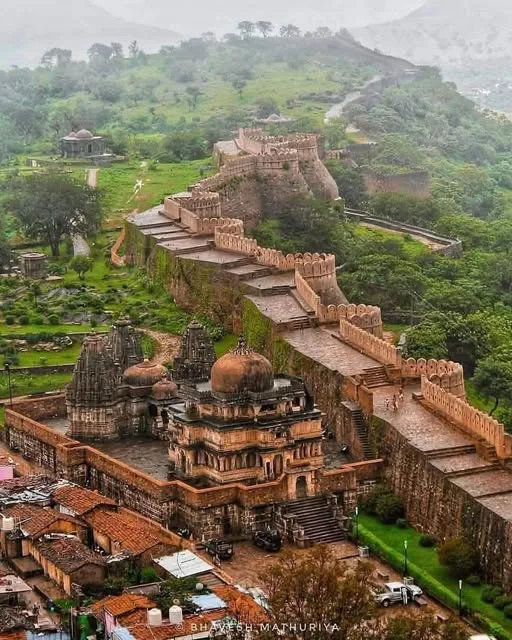The Great Wall of India: An In-Depth Look at Kumbhalgarh Fort Wall
The Kumbhalgarh Fort wall, a UNESCO World Heritage Site in Rajasthan, India, is not merely a boundary but a testament to Rajput military genius and architectural prowess. Its unparalleled length and strategic brilliance earn it the moniker “The Great Wall of India,” truly making it the world’s second-longest continuous wall after China’s iconic structure.

Construction and Purpose: A Masterpiece of Defense
Built by Rana Kumbha of the Mewar dynasty in the 15th century (specifically around 1448 AD), the fort and its wall were designed as an impregnable stronghold against invaders. Rana Kumbha was a prolific builder, credited with constructing 32 of the 84 forts in his dominion, with Kumbhalgarh being his grandest and most elaborate. The chief architect, Mandan, even documented his work in a text called Rajvallabh, highlighting the meticulous planning that went into this colossal project.
The strategic location on a hilltop, approximately 1,100 meters (3,600 feet) above sea level in the rugged Aravalli Mountain Range, naturally lent itself to defense. The wall was constructed to capitalize on this difficult terrain, winding its way over hills and through valleys, making it incredibly challenging for any invading army to breach.

Architectural Features and Defensive Innovations:
Length and Thickness: The wall stretches for a staggering 36 kilometers (22 miles). Its sheer scale is astonishing, with frontal walls reportedly 4.5 meters (15 feet) thick in places. This immense width was designed to allow eight horses to ride abreast on the ramparts, facilitating rapid movement of troops and supplies along the wall during attacks.
- Fortified Gateways: The wall incorporates seven fortified gateways (known as pols), each designed to withstand prolonged sieges. These gates often feature narrow entrances and iron spikes to deter elephant attacks, adding layers of defense. Notable gates include the Hanuman Pol and Ram Pol, with the Hanuman Pol being particularly significant as it’s said to mark the spot where a human sacrifice was made to overcome construction obstacles, a common legend associated with such grand projects.
- Watchtowers and Bastions: Along its length, the wall is dotted with numerous watchtowers and bastions (around 700 bunkers are mentioned), providing panoramic views of the surrounding landscape and enabling early detection of enemy movements.
- Hidden Passageways and Water Reservoirs: The fort was designed to be self-sufficient and resilient during prolonged sieges. It incorporated hidden passageways, secret chambers, and numerous water reservoirs and baoris (step-wells) to ensure a steady supply of water for its inhabitants, a crucial factor in its ability to withstand attacks. It was only due to a scarcity of drinking water that the combined forces of the Mughal Empire and Amber were able to breach it once.
A City Within Walls: Temples, Palaces, and More
Within the vast expanse protected by the Kumbhalgarh wall lies a veritable city, a testament to its dual function as both a fortress and a thriving center of life. The complex houses:
- Over 360 temples: A remarkable number, including around 300 ancient Jain temples and 60 Hindu temples. These temples showcase diverse architectural styles of the period.
- Neelkanth Mahadev Temple: Dedicated to Lord Shiva, this significant Hindu temple dates back to 1458 CE. It features a massive six-foot Shiva Lingam made of black granite and an open pillared Mandapa (hall) supported by 24 huge, intricately carved pillars. Pooja (worship) is still performed here.
- Vedi Temple: Built by Rana Kumbha himself, this three-storeyed octagonal Jain temple was constructed for performing rituals after the completion of the fort.
- Ganesh Temple: Situated on a 12-foot platform near Ram Pol, considered one of the earliest temples within the fort.
- Parsvanath Temple and Bawan Devi Temple: Other notable Jain temples showcasing the religious diversity within the fort. The Bawan Devi Temple is unique for its 52 shrines within a single complex.
Palaces:
- Badal Mahal (Palace of Clouds): Situated at the highest point of the fort, offering breathtaking panoramic views that stretch for kilometers, even allowing glimpses of the sand dunes of the Thar Desert on a clear day. This two-story palace is known for its intricate murals and vibrant colors.
- Kumbha Palace: Rana Kumbha’s royal residence, this palace, though simpler in design, holds immense historical value.
- Other structures: The fort also contains residential quarters, chhatris (cenotaphs), and various other ruins that speak to the vibrant life it once held.
Historical Significance:
Kumbhalgarh holds immense historical and sentimental significance for Rajasthan. It served as a vital refuge for the rulers of Mewar during times of strife, including sheltering the young Udai Singh II, who later founded Udaipur, during a turbulent period. It is also the revered birthplace of Maharana Pratap, the legendary Rajput warrior king renowned for his fierce resistance against the Mughal Emperor Akbar. The fort’s long-standing impregnability against direct assault symbolizes the indomitable spirit and resilience of the Rajputs.
Visiting Kumbhalgarh Today:
Today, the Kumbhalgarh Fort is a popular tourist destination, offering a captivating glimpse into India’s rich heritage. Visitors can:
- Walk along the walls: Experience the sheer scale and architectural marvel of the fortification.
Explore the palaces and temples: Delve into the cultural and artistic aspects of the fort. - Enjoy the light and sound show: Held in the evenings, this spectacular show narrates the fort’s history and legends.
- Visit the Kumbhalgarh Wildlife Sanctuary: The fort is surrounded by a sanctuary home to diverse wildlife, including leopards, wolves, and sloth bears.
- The “Great Wall of India” at Kumbhalgarh is more than just a historical monument; it’s an immersive experience that tells tales of valor, architectural brilliance, and the enduring spirit of a bygone era.





